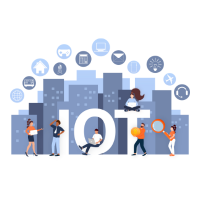
Introduction
In today’s fast-paced world, technology continues to evolve, and one of the most remarkable advancements we’ve witnessed is the Internet of Things (IoT). This revolutionary concept has transformed the way we interact with our surroundings and has the potential to connect the world in unprecedented ways. In this article, we will delve into the IoT revolution, exploring its impact on various aspects of our lives.

What is IoT?
IoT stands for the Internet of Things, and at its core, it refers to the interconnection of everyday objects and devices to the internet. These objects, which can range from smart thermostats and wearable fitness trackers to industrial machinery and autonomous vehicles, are embedded with sensors, software, and other technologies that allow them to collect and exchange data.

1.The Growth of IoT
A Global Phenomenon
The IoT revolution is truly global, with billions of devices already connected and many more on the horizon. From urban centers to remote rural areas, IoT is making its mark, creating a web of connectivity that spans the entire globe.
Industry Adoption
Industries of all kinds are embracing IoT to enhance efficiency, productivity, and decision-making. Manufacturing, healthcare, agriculture, and transportation are just a few sectors benefiting from IoT innovations.

2.The Impact on Daily Life
Smart Homes
IoT has made its way into our homes, making them smarter and more convenient. Smart thermostats, lighting systems, and security cameras allow homeowners to control and monitor their environments remotely.
Wearable Tech
Wearable devices like smartwatches and fitness trackers have become ubiquitous. They help us stay connected, track our health, and provide valuable data for personal improvement.

3.Challenges and Concerns
While the IoT revolution offers remarkable opportunities, it also comes with challenges and concerns that need to be addressed.
Security
With more devices connected to the internet, security becomes a paramount concern. Protecting data and privacy is essential as we navigate this interconnected world.
Data Overload
The sheer volume of data generated by IoT devices can be overwhelming. Effective data management and analysis are crucial to harness the full potential of IoT.
4.Future Prospects
The future of IoT is bright and full of possibilities. As technology continues to advance, we can expect:
Enhanced Connectivity
IoT will continue to expand its reach, connecting even more devices and enabling seamless communication between them.
Improved Efficiency
Industries will further optimize their operations, leading to increased efficiency, cost savings, and reduced environmental impact.
Conclusion
The IoT revolution is reshaping the way we live and work. It’s a testament to human innovation and our desire to create a more connected world. As IoT continues to evolve, it’s crucial to address its challenges while embracing its potential. The future promises even greater connectivity, efficiency, and convenience, making IoT a force that will shape our world for years to come.

FAQs
- Is IoT limited to smart home devices? No, IoT encompasses a wide range of devices across various industries, from healthcare to agriculture and beyond.
- How can I ensure the security of my IoT devices? To enhance security, keep your devices and software up to date, use strong passwords, and follow best practices for IoT security.
- What are some examples of wearable IoT technology? Wearable IoT technology includes smartwatches, fitness trackers, and even smart clothing that can monitor health and provide valuable data.
- What challenges does IoT pose in terms of data management? IoT generates vast amounts of data, which can be challenging to store, process, and analyze effectively. Proper data management strategies are essential.
- What can we expect from IoT in the coming years? The future of IoT holds promises of enhanced connectivity, improved efficiency, and even more innovative applications in various industries.


